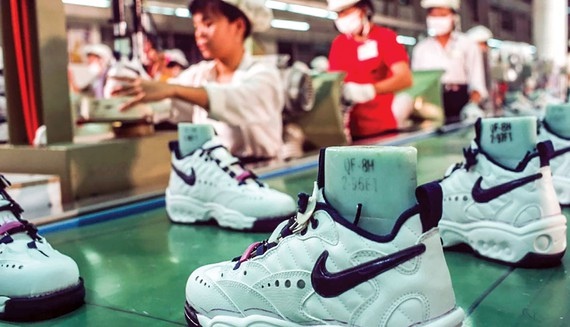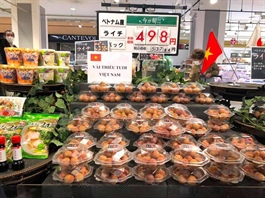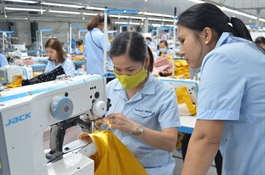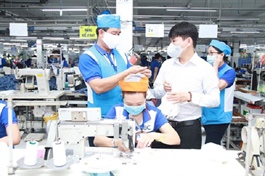Vietnam seen as manufacturing hub for global brands
Vietnam seen as manufacturing hub for global brands
During the fourth wave of the Covid-19 pandemic from June until September 2021, several fashion brands began to gradually move production and orders away from Vietnam.
Illustrative photo. |
This decision was made so as to reduce transport costs and adjust to the disruption in the supply chain, which has become a serious concern for many export-import businesses. Nonetheless, Vietnam still remains a huge manufacturing hub for several global fashion giants.
Vietnam role in supply chain
The Japanese fashion brand Uniqlo is familiar to many Vietnamese consumers. It opened its first shop in Vietnam in December 2019, and it has since opened nine retail shops in Hanoi and Ho Chi Minh City, along with a recently opened online shop. Uniqlo will certainly expand its business in Vietnam in the next few years, because Vietnam is considered a big market by the company due to its large young population, high per capita income, and a growing middle class. Furthermore, Vietnam is the second biggest manufacturing base for Uniqlo. In particular, Uniqlo purchases products of 45 Vietnamese apparel companies for the domestic and international markets. The company highly values the improved quality of the Vietnamese workforce.
The Vietnamese textile and footwear industry has become more and more important in the global supply chain of several international giants. The world famous brands Nike and Adidas are buyers from about 200 Vietnamese suppliers. For instance, Vietnam provides 30% of the products that Adidas supplies to the global market. Even during the peak of the Covid-19 pandemic in Southern Vietnam, Nike still trusted the Vietnamese suppliers the most. Viettien Garment Corporation, for instance, has not lost a single order from Nike despite the impact of the Covid-19 pandemic.
The latest figures from the World Trade Statistical Review 2021 released by the World Trade Organization show that Vietnam has overtaken Bangladesh to becoming the world's second largest exporter of readymade garments, reaching a market value of USD 29 bn in 2020, just behind China. Garments made in Vietnam make up 4.6% of the world market. Vietnam has recently produced lots of high quality garments because of the improved quality of its workforce.
Together with the garment sector, the Vietnamese footwear products are playing a more and more important role on the world stage. The Vietnam Industry and Trade Information Centre of the Ministry of Industry and Trade cited data from the World Footwear Yearbook, showing that Vietnam ranked second in the world in footwear exports, reaching 1.23 billion pairs in 2020.
With this result, for the first time Vietnam surpassed 10% of the world total footwear exports by reaching 10.2%, and increasing by 4.4 times compared to 2011 when it was just 2.3%, with 316 million pairs of shoes being exported. Vietnam has become the world's largest exporter of canvas shoes in terms of value, outstripping even China. This is the first time that China has not led the export of a particular type of footwear.
Several world famous footwear brands like Nike, Adidas, Reebok and Puma have had large quantities of their products made in Vietnam. The prospect of the Vietnamese footwear industry is very likely to go even further, since China continues to reduce incentives for investments in footwear in order to focus on high-tech technology, making international footwear orders move from China to Vietnam.
Commitment of Vietnamese companies
Despite the advantage of lower labor costs at a reasonable level, businesses are also making great efforts to invest more in technology to meet the increasingly strict requirements of buying partners.
Mr. Vu Duc Giang, Chairman of the Vietnam Textile and Apparel Association, explained why Nike has not moved any orders previously placed at Viettien Garment Corporation, because as of October when we reopened, Nike had not yet found another manufacturer capable of meeting its requirements in terms of time, quality and quality control like the ones in Vietnam. He also pointed out that only when the pressure of delivery time is too high, making it impossible to balance the delivery and sales time, do famous brands move their orders to manufacturers in countries that can satisfy these requirements.
However, a number of seasonal orders have been moved out of Vietnam to ensure the year end shopping season deliveries to major markets. Mr. Vu Duc Giang said that during the social distancing period, Vietnamese textile and garment companies could not meet the delivery schedule, so a certain number of orders for delivery in November and December were moved away, about an estimated 13% to 14%. Yet now there are signs of orders coming back. Similarly, the footwear industry also saw a small number of seasonal orders moved out of Vietnam.
The commitment and reputation of Vietnamese companies could also be one of the most important factors for foreign partners to feel secure for long term cooperation. The fourth wave of the Covid-19 pandemic that lasted from June until September in Vietnam obviously proved this point. As soon as businesses reopened in early October, factories immediately let workers work overtime, and some even arranged for products to be delivered by air at a cost several times higher than by sea, in order to have their products delivered as per the schedule, especially for the holiday season and coming new year.
In the long term, Vietnam's participation in many major Free Trade Agreements (FTAs) such as CPTPP or EVFTA will also be the reason why globally famous brands will prioritize Vietnam as a vital production base, because they can enjoy the tax incentives under these FTAs when products are exported from Vietnam. Buying partners also give priority to Vietnamese suppliers because of assurance of on time delivery, despite the many disruptions to the supply chain because of the ongoing Covid-19 pandemic.






















